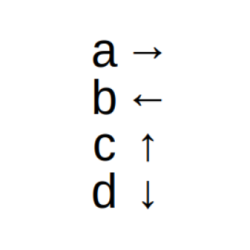User:MLavazza/Sandbox2: Difference between revisions
No edit summary |
No edit summary |
||
| Line 12: | Line 12: | ||
<div class="side-by-side-image-row"> | <div class="side-by-side-image-row"> | ||
<div class="side-by-side-image-container"> | <div class="side-by-side-image-container"> | ||
[[File: | [[File:Screenshot of 115,150-a.png|250px|center|class=img-comfy]] | ||
<p class="image-caption">Example of point one above: the spatial configuration of letters and arrows | <p class="image-caption">Example of point one above: the spatial configuration of letters and arrows in [http://www.wittgensteinsource.org/Ms-130,100_f Ms-115, page 150] was transcribed using XML markup which is translated by the parser into an HTML table containing Unicode characters and rendered by the browser as above.</p> | ||
</div> | </div> | ||
<div class="side-by-side-image-container"> | <div class="side-by-side-image-container"> | ||
[[File:Previous generation images - 130,100.jpg|250px|center|class=img-comfy]] | [[File:Previous generation images - 130,100.jpg|250px|center|class=img-comfy]] | ||
<p class="image-caption">Example of point two above: the early redrawn version of Wittgenstein's graphic in [http://www.wittgensteinsource.org/Ms-130,100_f Ms-130, page 100].</p> | <p class="image-caption">Example of point two above: the early redrawn version of Wittgenstein's graphic in [http://www.wittgensteinsource.org/Ms-130,100_f Ms-130, page 100] was this JPG file.</p> | ||
</div> | </div> | ||
</div> | </div> | ||
| Line 43: | Line 43: | ||
<div class="side-by-side-image-container"> | <div class="side-by-side-image-container"> | ||
[[File:Unicode graphics placeholder.png|250px|center|class=img-comfy]] | [[File:Unicode graphics placeholder.png|250px|center|class=img-comfy]] | ||
<p class="image-caption">Current placeholder.</p> | <p class="image-caption">Current placeholder for graphics and figures encoded in the transcriptions using XML markup and Unicode characters.</p> | ||
</div> | </div> | ||
<div class="side-by-side-image-container"> | <div class="side-by-side-image-container"> | ||
[[File:Example of the desired look of Unicode graphics.png|250px|center|class=img-comfy]] | [[File:Example of the desired look of Unicode graphics.png|250px|center|class=img-comfy]] | ||
<p class="image-caption">.</p> | <p class="image-caption">Desired look of a future implementation of graphics and figures encoded in the transcriptions using XML markup and Unicode characters (example based on [http://www.wittgensteinsource.org/Ms-130,100_f Ms-115, page 150]).</p> | ||
</div> | </div> | ||
</div> | </div> | ||
Revision as of 12:57, 20 July 2024
History
As most Wittgenstein scholars and enthusiasts are well aware, the Wittgenstein Archives at the University of Bergen maintain a rich collection of online resources related to Ludwig Wittgenstein's Nachlass.
In particular, since 2012, the WAB's "Semantic faceted search and browsing" (SFB) website allows readers and researchers across the globe to search, filter and display individual remarks from the Nachlass, or collections thereof, based upon their content or relevant metadata. Since 2016, the WAB's "Interactive dynamic presentation" (IDP) website makes it possible for users to view entire manuscripts or typescripts, in a linear or diplomatic style, while dynamically selecting which sets of information to display.
Both websites use dedicated software to index and parse the WAB's transcriptions of Wittgenstein's manuscripts and typescripts. These are based on the handwritten or typed material and are encoded as XML files according to the TEI guidelines. While they were originally published as part of the CD-based Bergen Electronic Edition, the SFB and IDP websites now allow anyone who has an Internet connection to easily browse them.
As of late 2022, the many graphics and figures that Wittgenstein had included in the 20.000 pages he wrote were rendered by these transcriptions in one of two ways:
- Some had been encoded using a combination of Unicode characters (such as letters, numbers, dashes, arrows...) and XML markup that the IDP parsing engine renders as HTML;
- Others (generally speaking, those that were visually more complex) had been redrawn, as had previously been done by publishers with the drawings included in Wittgenstein's writings that had appeared in print.
Example of point one above: the spatial configuration of letters and arrows in Ms-115, page 150 was transcribed using XML markup which is translated by the parser into an HTML table containing Unicode characters and rendered by the browser as above.
Example of point two above: the early redrawn version of Wittgenstein's graphic in Ms-130, page 100 was this JPG file.
The quality and consistency of the WAB's redrawn graphics, however, was not considered entirely satisfactory. This prompted Alois Pichler, director of the WAB, and Michele Lavazza, coordinator of the Ludwig Wittgenstein Project, to start a cooperation intended to redraw all these visuals.
With funding from the WAB, the project lasted from October 2022 to April 2024 and resulted in the recreation of approximately 1000 image files which were embedded in the transcriptions (and thus incorporated in the public sites) as they became available. The drawings were made by Michele Lavazza and graphic designer Sara Lavazza under the supervision and coordination of Alois Pichler. Precious help and consultancy was provided by Michael Biggs, Rune Falch, and Daphne Bielefeld.
After the completion of the redrawing phase, it started to seem desirable that the image files should also become available – i.e., browsable and searchable – in and of themselves, and not only as an integral part of the manuscripts. Thus, Michele Lavazza built this website (Wittgenstein Nachlass Graphics) to host the files and used data from the WAB's XML transcriptions, combined with a database-like infrastructure powered by Semantic MediaWiki, to make it possible to search and filter them by description tags as well as by manuscript number. In this task, he received help from Frederic Kettelhoit and continued working in cooperation with Alois Pichler.
Finally, at this stage, it became clear that an added value would be provided by the fact of also indexing the visuals that had been rendered in the WAB's transcriptions by the abovementioned combination of Unicode characters and XML tags. These are currently represented by grey placeholders that merely serve the purpose of being the bearers of the semantic tags (more on this topic in the "User guide" below). It is our hope that in the future, with the evolution and continuous improvement of the transcriptions, it will become possible to also include their visual appearance in this website.
Current placeholder for graphics and figures encoded in the transcriptions using XML markup and Unicode characters.
Desired look of a future implementation of graphics and figures encoded in the transcriptions using XML markup and Unicode characters (example based on Ms-115, page 150).
Scope and purpose
This website contains high-quality, "normalised", redrawn visuals that correspond to the hand-drawn graphics and figures from the manuscripts and typescripts in Ludwig Wittgenstein's Nachlass. The choice as to which graphics to recreate was based on which visual items of the originals had already been redrawn (as opposed as rendered as Unicode+XML) as of October 2022.
These drawings are tagged with semantic descriptors that were imported from the WAB's transcriptions by parsing the XML files with a dedicated script.
Additionally, it contains a placeholder for each item, encoded in the transcription as Unicode+XML, that was tagged as a "graphic" as opposed as a "" or "" (type="graphic").
User guide
Naming conventions
File formats
Viewing online and downloading
Semantic tags and searching
Copyright
The drawings are licenced under Creative Commons Attribution-ShareAlike 4.0. This means that the image files can be freely downloaded without asking for permission or paying a fee and can be reused for any purpose, including commercial, provided that:
- The authors are credited, if possible with the following format:
- Any derivative works (i.e., drawings based upon these drawings) are also licenced under Creative Commons Attribution-ShareAlike 4.0.
The rights to the semantic tags (i.e., to the relationship between the image files and the descriptors) belong to the WAB. The copyright holders (The Master and Fellows of Trinity College, Cambridge and the University of Bergen, Bergen, in agreement with Oxford University Press) released the transcriptions of a subset of the manuscripts (Ts-201a1, Ts-201a2, Ms-139a, Ts-207, Ms-114, Ms-115, Ms-153a, Ms-153b, Ms-154, Ms-155, Ms-156a, Ms-148, Ms-149, Ms-150, Ts-212, Ts-213, p.39v of Ms-140, Ms-141, Ms-152, Ts-310) under Creative Commons Attribution-NonCommercial 4.0, meaning that the semantic tags are also available under the same licence; all rights to the transcriptions of the other manuscripts are reserved.




